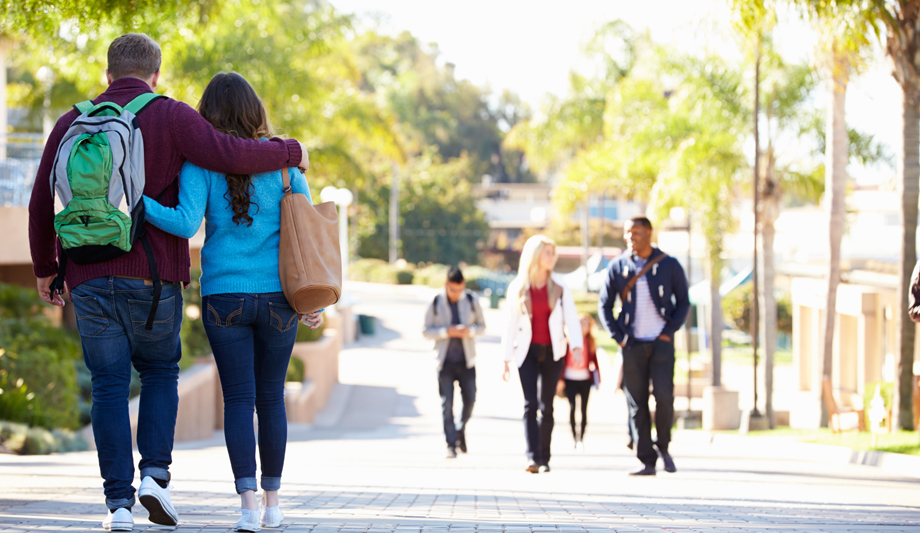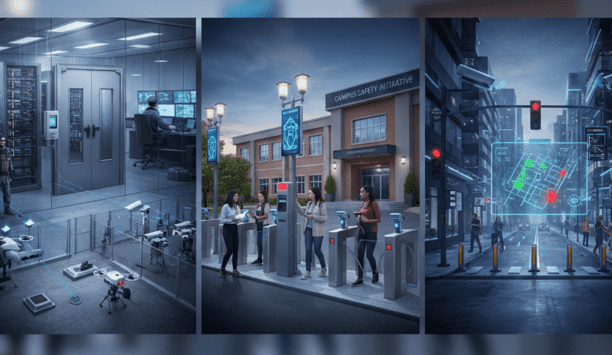Large campuses – colleges and universities, hospitals and office parks – face difficult security challenges in protecting people and property across wide-open outdoor spaces. Outdoor security requires a different approach. The locks, alarms and access control solutions used for buildings have little impact outdoors.
Outdoor security may include protecting a student on an early morning run; a nurse walking to a bus stop at the end of a late-night shift; or possibly securing athletic fields, parking structures, landscaped gardens or performance amphitheaters.
One constant between securing the indoor and outdoor environments is the need for multiple security layers. No single solution can meet all security needs.
Outdoor surveillance
Information – both visual and audio – takes on added importance as security guards and first responders need input from areas that may be hundreds of yards away from the nearest dispatch center. This is one reason video surveillance is an effective outdoor security tool.
Pan-Tilt-Zoom megapixel cameras can provide sharp images of wide areas. Infrared cameras continue providing useable images throughout the night, even in low-light environments. Recorded video also provides forensic views to be used in assessing events after they have occurred.
Cameras have long been shown to be a deterrent for many criminals. So, it makes sense to post signs throughout the campus reminding people they are likely to be under surveillance at any time.
 |
| Emergency stations are ideal for any outdoor area |
Emergency stations
Emergency stations are another valuable outdoor security tool. These stations are easily recognisable by their bright blue lights atop the tower. With a touch of a button, a distressed person can immediately speak with a security guard via imbedded audio intercoms. Video intercoms provide additional views of the area to help dispatchers make decisions about an emergency. The stations can also be integrated with the video surveillance system to provide a broader view of the area.
There are other important benefits offered by emergency stations. They are on and available 24/7. Dispatchers immediately know the station’s precise location when calls for assistance arrive. A station’s speakers can broadcast emergency information across the campus. And the intercoms feature two buttons – one for emergencies and a second for non-critical calls, such as inquiries for campus directions.
The stations are designed for easy setup by integrators or campus engineers. The units are available in IP-based models which connect to the campus network and draw power over the Ethernet using CAT-5e/6 cable. Stations are also available as stand-alone towers or wall-mounted boxes. Braille signage and adjustable call button heights allow them to comply with ADA standards.
Emergency stations are ideal for any outdoor area such as running trails, parking lots, pedestrian pathways and perimeters around office buildings, dorms and recreational centers. They are also useful indoors in areas including elevator bays and stairwells. Ideally, the stations should be placed close enough to allow a distressed person an option of choosing the closest unit.
 |
| The proliferation of smartphones in the campus environment has led to the development of dozens of apps capable of reaching security or local first responders |
Mobile applications
Unlike telephone-based systems, intercom stations require no POTS line, saving monthly phone costs. Mobile apps are also available to allow patrolling guards to have immediate access to emergency calls on a smartphone or tablet.
Over the past few years, the proliferation of smartphones in the campus environment has led to the development of dozens of apps capable of reaching security or local first responders. Most allow the submission of voice and video and may offer other features such as the ability to track friends’ progress as they walk to their destination.
While these apps do serve as another valuable layer of outdoor security, they have limitations. They are only useable for people who have enrolled in a campus database. That eliminates students and/or employees who choose not to enroll or campus visitors.
Weather, topography and the proximity of cell towers can affect signal quality, making it difficult for security to accurately identify the precise location of calls. Some remote campus areas may totally lack cellular coverage. Then, too, phones have no value if the battery is dead or is taken in a robbery. Also, they can be difficult to remove from a pocket, purse or backpack if a victim is being attacked or chased.
The lessons from CPTED (Crime Prevention Through Environmental Design) certainly apply when protecting campus outdoor space. Lighting is critical along pathways, in parking lots and garages and surrounding building perimeters. It not only deters criminals, but also allows security to have a better view of situations either onsite or via surveillance camera or video intercom.
 |
| Keeping bushes and trees well-trimmed helps deny criminals easy hiding places |
Additional outdoor security precautions
Keeping bushes and trees well-trimmed helps deny criminals easy hiding places. Fencing and locked gates keep people from wandering into potentially dangerous areas. Fences and gates also works well to protect outdoor storage lots and equipment yards.
Many campuses, particularly universities and hospitals, have formed escort services. Either security guards or carefully screened volunteers are available to accompany students or employees crossing the campus at night.
Outdoor campus security requires well thought-out plans incorporating layers of security equipment. As with any security project, outdoor improvements should follow a thorough risk assessment conducted by an experienced consultant or integrator. Identifying a campus’ strengths and weaknesses will help administrators better spend limited budgets.
Campuses may range in size from a few to hundreds of acres. But even the smallest offer significant challenges in protecting outdoor spaces. In the case of colleges and universities, the pressure to keep people safe has never been greater with federal mandates requiring regular crime reports.
Fortunately, the security industry has responded with a range of tools to handle the challenge. With careful planning and implementation, a campus’ outdoor spaces can be made much safer.
From facial recognition to LiDAR, explore the innovations redefining gaming surveillance

























